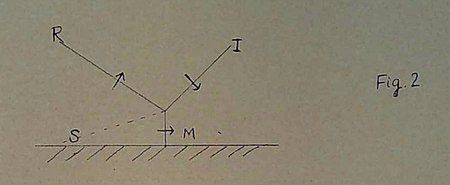
Fig. 2
in which the line of intersection of the incident and the reflected shocks no longer remains in contact with the wall but moves away from it. Under these circumstances a new shock wave (the Mach wave) is formed and moreover in the region included between the reflected and the Mach wave there is a surface of discontinuity . Across the normal components of the velocities remain continuous while there is a discontinuity in the tangential components: in other words, is a vortex sheet. Strictly speaking, the idealization of the Mach effect in terms of plane shock waves and a plane of discontinuity cannot be valid. For at the reflecting surface (assumed rigid) the motion of the gas must be parallel to the wall and this cannot in general be accomplished on both sides of the Mach front. However, it would seem that if we are prepared to ignore this difficulty of the boundary condition on the reflecting surface behind the Mach front the idealization of the Mach effect in terms of plane shocks and a plane vortex sheet may provide a 'first' approximation to the true situation. In other words, we are led to examine the conditions under which three shock waves can be in equilibrium. In this note we shall present certain results relating to this problem.
2. The stationary Mach effect. Physical considerations would suggest that a particularly interesting case of the (idealized) Mach effect arises when the vortex sheet is parallel to the reflecting wall (Fig. 3). Such solutions may be regarded as limiting cases of the situation depicted in Fig. 2.

Fig. 3



